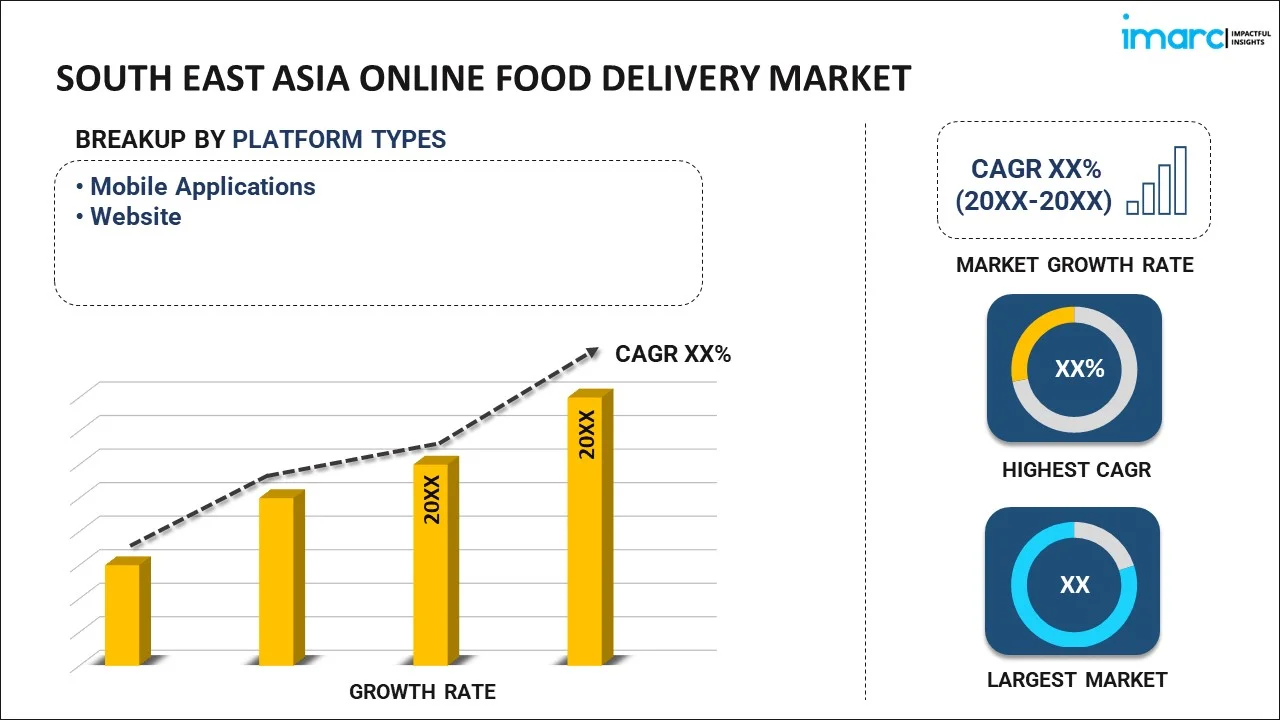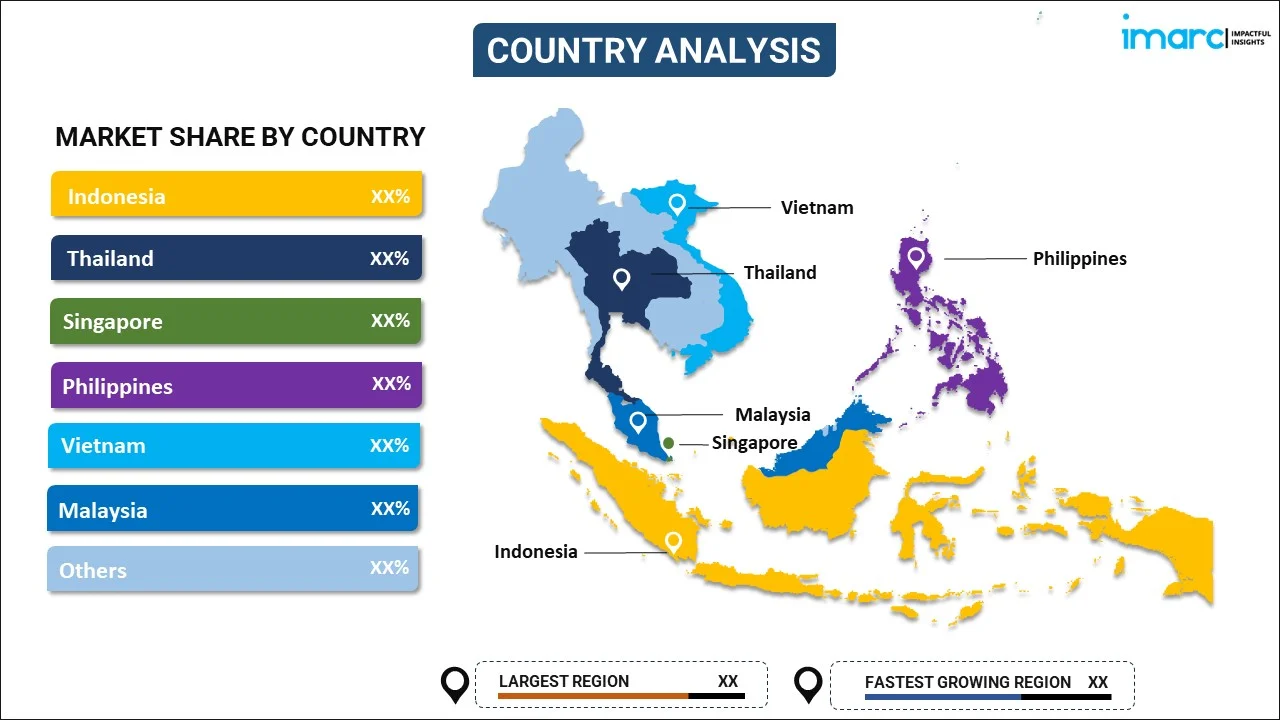
South East Asia Online Food Delivery Market Report by Platform Type (Mobile Applications, Website), Business Model (Order Focused Food Delivery System, Logistics Based Food Delivery System, Full-Service Food Delivery System), Payment Method (Online Payment, Cash on Delivery), and Country 2024-2032
Market Overview:
South East Asia online food delivery market size is projected to exhibit a growth rate (CAGR) of 15.96% during 2024-2032. The growing focus on eco-friendly packaging and sustainable delivery practices, improvements in app features, user interfaces, and order tracking to enhance the experience of people, and changing lifestyles of individuals represent some of the key factors driving the market.
|
Report Attribute
|
Key Statistics
|
|---|---|
|
Base Year
|
2023 |
|
Forecast Years
|
2024-2032
|
|
Historical Years
|
2018-2023
|
| Market Growth Rate (2024-2032) | 15.96% |
Online food delivery is a modern service that allows individuals to order food from a variety of restaurants through digital platforms, such as mobile applications or websites. It is accessible to a wide range of people, including those with mobility challenges or individuals living in areas with limited dining options. It ensures that everyone can access a variety of food choices conveniently. It allows people to browse menus, select their desired dishes, and complete the transaction online. It enables individuals to enjoy meals without physical contact with restaurant staff or delivery person, promoting safety and hygiene. It also allows people to customize their orders, specifying preferences or dietary restrictions. It offers enhanced convenience and eliminates the need to physically visit a restaurant to place an order. It provides doorstep delivery options that allow people to enjoy meals in the comfort of their homes or workplaces. It also offers a wide range of culinary options, allowing consumers to explore diverse cuisines and menus from various restaurants within their delivery radius. As it provides flexible payment methods, including credit cards, digital wallets, and cash-on-delivery (COD) options, the demand for online food delivery is increasing in South East Asia.
South East Asia Online Food Delivery Market Trends:
At present, the rising adoption of online food delivery, as it eliminates the need to travel to a restaurant, wait in lines, or deal with traffic, represents one of the primary factors contributing to the growth of the market in South East Asia. In line with this, the growing demand for online food delivery due to changing lifestyles of individuals is offering a positive market outlook. Moreover, increasing preferences for online food delivery, as it provides a wide selection of dining options to people, is bolstering the market growth in the region. Apart from this, there is a rise in the demand for home delivery solutions among people with busy lifestyles. This, coupled with the increasing utilization of smartphones and the ease of internet facilities, is supporting the market growth. Additionally, improvements in app features, user interfaces, and order tracking to enhance the experience of people are strengthening the market growth. Besides this, the escalating demand for online food delivery platforms, as they provide coupons and discounts to attract a large consumer base, is positively influencing the market in South East Asia. Furthermore, the rising utilization of online food delivery to provide transparency in tracking orders is offering lucrative growth opportunities to industry investors. In addition, the increasing focus on eco-friendly packaging and sustainable delivery practices is propelling the market growth in South East Asia.
South East Asia Online Food Delivery Market Segmentation:
IMARC Group provides an analysis of the key trends in each segment of the market, along with forecasts at the regional and country levels for 2024-2032. Our report has categorized the market based on platform type, business model, and payment method.
Platform Type Insights:

- Mobile Applications
- Website
The report has provided a detailed breakup and analysis of the market based on the platform type. This includes mobile applications and website.
Business Model Insights:
- Order Focused Food Delivery System
- Logistics Based Food Delivery System
- Full-Service Food Delivery System
A detailed breakup and analysis of the market based on the business model have also been provided in the report. This includes order focused food delivery system, logistics based food delivery system, and full-service food delivery system.
Payment Method Insights:
- Online Payment
- Cash on Delivery
The report has provided a detailed breakup and analysis of the market based on the payment method. This includes online payment and cash on delivery.
Country Insights:

- Indonesia
- Thailand
- Singapore
- Philippines
- Vietnam
- Malaysia
- Others
The report has also provided a comprehensive analysis of all the major regional markets, which include Indonesia, Thailand, Singapore, Philippines, Vietnam, Malaysia, and Others.
Competitive Landscape:
The market research report has also provided a comprehensive analysis of the competitive landscape in the market. Competitive analysis such as market structure, key player positioning, top winning strategies, competitive dashboard, and company evaluation quadrant has been covered in the report. Also, detailed profiles of all major companies have been provided. Some of the key players include:
- Deliveroo
- Foodpanda
- Grab
- Gojek
- LINE Man
(Please note that this is only a partial list of the key players, and the complete list is provided in the report.)
South East Asia Online Food Delivery Market Report Coverage:
| Report Features | Details |
|---|---|
| Base Year of the Analysis | 2023 |
| Historical Period | 2018-2023 |
| Forecast Period | 2024-2032 |
| Units | US$ Million |
| Scope of the Report | Exploration of Historical and Forecast Trends, Industry Catalysts and Challenges, Segment-Wise Historical and Predictive Market Assessment:
|
| Platform Types Covered | Mobile Applications, Website |
| Business Models Covered | Order Focused Food Delivery System, Logistics Based Food Delivery System, Full-Service Food Delivery System |
| Payment Methods Covered | Online Payment, Cash on Delivery |
| Countries Covered | Indonesia, Thailand, Singapore, Philippines, Vietnam, Malaysia, Others |
| Companies Covered | Deliveroo, Foodpanda, Grab, Gojek, LINE Man, etc. (Please note that this is only a partial list of the key players, and the complete list is provided in the report.) |
| Customization Scope | 10% Free Customization |
| Report Price and Purchase Option | Single User License: US$ 3699 Five User License: US$ 4699 Corporate License: US$ 5699 |
| Post-Sale Analyst Support | 10-12 Weeks |
| Delivery Format | PDF and Excel through Email (We can also provide the editable version of the report in PPT/Word format on special request) |
Key Questions Answered in This Report:
- How has the South East Asia online food delivery market performed so far and how will it perform in the coming years?
- What has been the impact of COVID-19 on the South East Asia online food delivery market?
- What is the breakup of the South East Asia online food delivery market on the basis of platform type?
- What is the breakup of the South East Asia online food delivery market on the basis of business model?
- What is the breakup of the South East Asia online food delivery market on the basis of payment method?
- What are the various stages in the value chain of the South East Asia online food delivery market?
- What are the key driving factors and challenges in the South East Asia online food delivery?
- What is the structure of the South East Asia online food delivery market and who are the key players?
- What is the degree of competition in the South East Asia online food delivery market?
Key Benefits for Stakeholders:
- IMARC’s industry report offers a comprehensive quantitative analysis of various market segments, historical and current market trends, market forecasts, and dynamics of the South East Asia online food delivery market from 2018-2032.
- The research report provides the latest information on the market drivers, challenges, and opportunities in the South East Asia online food delivery market.
- Porter's five forces analysis assist stakeholders in assessing the impact of new entrants, competitive rivalry, supplier power, buyer power, and the threat of substitution. It helps stakeholders to analyze the level of competition within the South East Asia online food delivery industry and its attractiveness.
- Competitive landscape allows stakeholders to understand their competitive environment and provides an insight into the current positions of key players in the market.
Need more help?
- Speak to our experienced analysts for insights on the current market scenarios.
- Include additional segments and countries to customize the report as per your requirement.
- Gain an unparalleled competitive advantage in your domain by understanding how to utilize the report and positively impacting your operations and revenue.
- For further assistance, please connect with our analysts.
 Inquire Before Buying
Inquire Before Buying
 Speak to an Analyst
Speak to an Analyst
 Request Brochure
Request Brochure
 Request Customization
Request Customization




.webp)




.webp)












